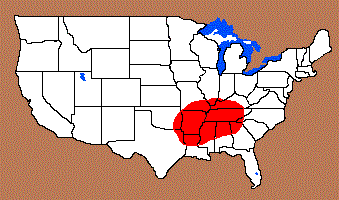Outline is Representative of Size and Shape:

Name Details:
Identified By: James A. Brown
Named For: Duck River Cache
Date Identified: 1976
Type Site: Duck River Cache, Humphreys County, Tennessee
Identified By: James A. Brown
Named For: Duck River Cache
Date Identified: 1976
Type Site: Duck River Cache, Humphreys County, Tennessee
Point Validity:
Valid type
Brown is a well-respected anthropologist and professor at Northwestern University who has conducted extensive studies at the Spiro Mounds in Oklahoma. This type was named in a professional publication and has limited professional references, possibly due to the small number of examples found. This is considered a valid type.
Brown is a well-respected anthropologist and professor at Northwestern University who has conducted extensive studies at the Spiro Mounds in Oklahoma. This type was named in a professional publication and has limited professional references, possibly due to the small number of examples found. This is considered a valid type.
Duck River Ceremonial Blade
Cluster: Description of Physical Characteristics and Flaking Pattern:
This is a very large ovoid blade with an elliptical cross section. The blade is narrow and excurvate with the tip curving in with parallel edges, and contracting towards the base. The tip is commonly acuminate. The base is convex. This point commonly has a random flaking pattern which is formed by an almost collateral flaking pattern (no median ridge) with fine pressure flaking on the edges. This blade has a high quality of workmanship.
Size Measurements:
Total Length - 200 to 350 mm, Width - 30 to 40 mm (***based on small sample size***)
Total Length - 200 to 350 mm, Width - 30 to 40 mm (***based on small sample size***)
Commonly Utilized Material:
Additional Comments:
This blade was named for the Duck River cache which contained 46 ceremonial artifacts including large blade or sword like artifacts. These blades are usually found in ceremonial or burial context. The largest was found at Etowah in northern Georgia.
These blades were used in ceremonial dances held by winged eagle dancers. A shell gorget was found at Hixton site in Hamilton County, Tennessee showed two feathered dancers. Madeline Kneberg described the dancers as having a “Duck River type artifact:” in one hand and a crescent shaped object in the other hand.
This blade was named for the Duck River cache which contained 46 ceremonial artifacts including large blade or sword like artifacts. These blades are usually found in ceremonial or burial context. The largest was found at Etowah in northern Georgia.
These blades were used in ceremonial dances held by winged eagle dancers. A shell gorget was found at Hixton site in Hamilton County, Tennessee showed two feathered dancers. Madeline Kneberg described the dancers as having a “Duck River type artifact:” in one hand and a crescent shaped object in the other hand.
Distribution:
Distribution Comments:
This point is primarily most commonly associated with ceremonial centers and burials. Caches have been reported from Duck River in western Tennessee to Etowah in northern Georgia and the Spiro Mound in eastern Oklahoma.
This point is primarily most commonly associated with ceremonial centers and burials. Caches have been reported from Duck River in western Tennessee to Etowah in northern Georgia and the Spiro Mound in eastern Oklahoma.
Age / Periods:
Date: 1,100 - 600 B.P.
Cultural Period: Mississippian
Glacial Period: Medieval Warm
Culture:
Date: 1,100 - 600 B.P.
Cultural Period: Mississippian
Glacial Period: Medieval Warm
Culture:
Age Details:
Similar Points:
Adena Blade, Benton Blade, Cotaco Blade, Morse Knife, Snake Creek Blade, Tennessee River
Adena Blade, Benton Blade, Cotaco Blade, Morse Knife, Snake Creek Blade, Tennessee River
Ot5her Ceremonial Type Points:
Dagger Knife, Duck River Blade, Morse Knife, Snake Creek Blade, Ramey Knife, Ross Blade
Dagger Knife, Duck River Blade, Morse Knife, Snake Creek Blade, Ramey Knife, Ross Blade

